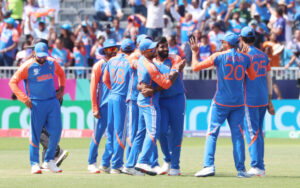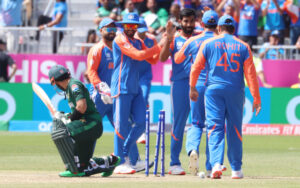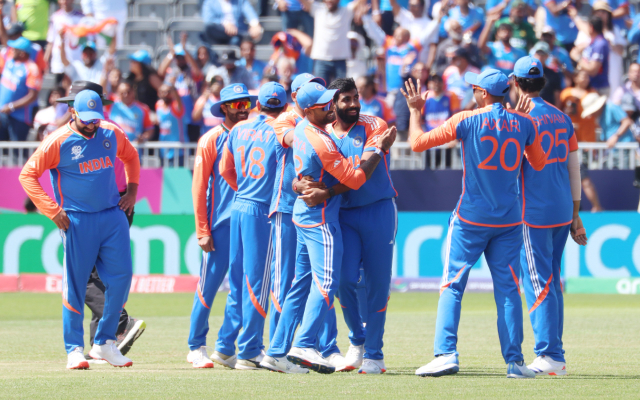
Hosts USA won their first ICC T20 World Cup match, which was the very first of the tournament. It was symbolically significant, since the competing nations were the very first two nations to play an international match in 1844.
The following day we witnessed a low-scoring tied match between Namibia and Oman, which the former won thanks to David Weise’s heroics in the Super Over with bat and ball.
The next day Sri Lanka registered their lowest score in a T20 international, a paltry 77 off 115 balls, with South Africa’s Anrich Nortje registering his career best of 4 for 7 in his allotted 24 deliveries.
Uganda followed in Sri Lanka’s footsteps on the same day to register their lowest T20 international score of just 58 against the Afghans. Fazalhaq Farooqi’s pace was unplayable as was Nortje earlier in the day. He, too, grabbed career best figures of 5 for 9.
The next morning, Scotland threatened their neighbours England with a rollicking start of 90 for no loss in the first 10 overs, in an otherwise low scoring tournament thus far. Rain played spoilsport, else who knows if we were heading towards a ‘Brexit’ level upset?
Uganda pulled up their socks with a day’s break and registered their first ever win in a T20 World Cup, which came against Papua New Guinea. Twenty-six-year-old Pakistan-born Riazat Ali Shah was the hero of the day, who saw his nation home.
Unfortunately, his home nation couldn’t hold their nerves the next day against the co-hosts, USA and we witnessed another thrilling Super Over contest, which could have extended to another Super Over contest if Shadab Khan could have disposed of the final ball of Saurabh Netravalkar’s over for a six.
For the Latest Sports News: Click Here

The multi-talented Oracle techie, who had represented India U19 in 2010, kept his cool and managed to dart the ball away from the batsmen outside off with three fielders guarding the deep boundaries and thus restricting scoring options.
Earlier in the day, Steve Taylor took a stunner in the slip to dismiss Rizwan off Netravalkar; Kenjige picked up three crucial wickets. Monank played a captain’s knock to score a half century, with Nitish Kumar and the rising stock, Aaron Jones piling on a quick 48 runs in 23 balls to tie Pakistan’s 159. Aaron continued his magic in the Super Over, where USA made 18 against Mohammed Amir.
This major upset threw open the tournament alive as Sunday’s India-Pakistan duel became all the more consequential. More importantly, it ensured that the sport reached millions of American households, outside of the 5 million strong desi diaspora, thanks to CNN providing rich post-match coverage.
The entertainment hasn’t stopped since then.
Scotland beat Namibia for the first time in T20Is, thanks to skipper Berrington and Michael Leask’s inspiring 74 run partnership.
A day later, another North American team scripted an upset, when Canada registered their first ever win in a T20 World Cup, when they made a match out of a low scoring game, restricting Ireland to 125 to win the game by 12 runs. They upset a nation that is usually known to script upsets against Full Member teams in World Cups. Jeremy Gordon, Saad Bin Zafar and Dilon Heyliger’s economy deserves some maple syrup celebration.
Afghanistan can’t be considered minnows anymore, as they have beaten sides like West Indies and Pakistan in the past. But then, no one would have expected them to beat the mighty Kiwis by a hefty 84-run margin. Farooqi & Rashid Khan ripped through the heart of the New Zealand unit, leaving them with an embarrassing outing.

In the following game, the Bangladesh Tigers beat their South Asian rivals Sri Lanka by 2 wickets to register their first ever win against them in a T20 World Cup.
It’s just been a week since the start of the tournament and the TRP ratings and social media engagement have begun to shoot up and we are yet to hit the business end of the tournament.
The viewership of the India-Pakistan duel skyrocketed. That India won the big tie in one of the most historical rivalries kept the audience glued.
Given what we have witnessed thus far, the T20 format is ideal to help globalise the game of cricket. No, not least because of the shorter duration and dancing cheerleaders, but because it’s economically accessible and they can be hosted on drop-in pitches. The rules have made most matches an electrifying run-feast until the pitch plays tricks like the way the Nassau County International Cricket Stadium has in the last fortnight.
The volatility of a T20 game keeps the uncertainty quotient high and has the fan guessing. And that’s exactly what makes live sports captivating, interesting and engaging.
This T20 World Cup is an interesting experiment in the globalisation of cricket and if it does well, it would augur well for the LA 2028 Olympics to further accelerate the growth of the sport.
Also Read: NRIs thrilled with Team India win against Pakistan




